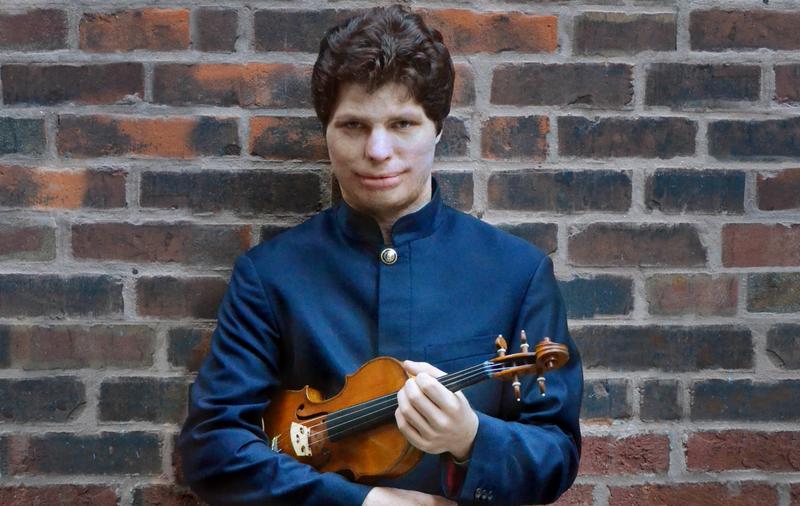Violinist Hadelich gives a virtuosic performance of Britten rarity with Oundjian, New World
After fleeing England in 1939 as war loomed, Benjamin Britten produced what would become one of the most obscure violin concertos by a significant composer. The concerto received its premiere at a concert of the New York Philharmonic and went on to be recorded several times, but it still rarely makes it into concert halls.
The New World Symphony, guest conductor Peter Oundjian and violinist Augustin Hadelich deserve credit for allowing South Florida listeners to hear a live performance of this grim and substantial work.
Britten’s Violin Concerto, performed Saturday at New World Center in Miami Beach, demands that the soloist execute all the technical tricks of a virtuoso work of Paganini—left-hand pizzicatos, glassy harmonics, staccato bowing and rapid-fire playing to the upper reaches of the instrument’s range. But it does so in the service of the work with very little surface flash, but in music that is instead agonized, diabolical, mysterious and ambiguous.
The concerto creates a unique sound, with the violin often playing near its top range over a brooding accompaniment in low instruments such as timpani or trombones, establishing an aural space of vast breadth. Hadelich, a virtuoso of the first order, was a master of the instrument’s top range, playing with a clear, penetrating tone just where some of his colleagues weaken.
He played the opening movement in a rhythmically free manner, tugging at phrases to draw them out. The second movement is a scherzo-like rush of sound, with the violin chopping away in rapid, sardonic passages that recall Shostakovich and Prokofiev. Hadelich powered through these passages with authority and fire, creating tones of rugged force in runs of two simultaneous notes.
The concerto concludes with a long passacaglia, a set of variations over a repeated bass line. The movement opened with a high violin passage over trombones and proceeded through dark and searching episodes to an orchestral passage that seemed triumphant, a major-key affirmation that would have been in the pattern of so many works that travel from darkness to light. Then it quieted, as Hadelich’s playing returned, with the violinist drawing maximum tension from a series of cadences that brought the concerto to an ambiguous conclusion.
Britten’s orchestration creates unusual textures that were effectively executed by the New World musicians under Oundjian, such as a tuba melody under a chirpy accompaniment in piccolos. While this is one of those concertos that keeps the soloist busy pretty much throughout, there were passages of symphonic grandeur, particularly in the intense middle movement, delivered by the orchestra with thunderous force and crisp authority. And throughout, Oundjian collaborated with Hadelich to maintain consistent tension, as violins or winds played Britten’s pensive melodies with icy clarity through the elaborate passagework of the soloist.
As an encore, Hadelich played the Sarabande from Bach’s Partita No. 2 for solo violin, playing the chords in an inward, sensitive manner that avoided the rolling, organ-like approach taken by other violinists.
The concert opened with New World conducting fellow Dean Whiteside leading a performance of Aaron Copland’s An Outdoor Overture, a 1938 work composed for the young musicians of New York’s High School of Music and Art.
The outer sections were full of Copland’s trademark raucous rural energy, with the musicians sawing, banging and puffing away in a manner that was accurate but never fussily precise. But the most effective parts of the work came in the quieter middle section, with gentle flute and clarinet solos, and in the softer melody in the violins over an accompaniment in the winds.
In the shorthand descriptions sometimes given to Brahms’ symphonies, where the Third is heroic and the Fourth tragic, the composer’s sunny Symphony No. 2 is often labeled his “pastoral” symphony.
That’s an oversimplification for a work that’s shot through with shadows. But there is a decidedly genial tone to much of the symphony, and Oundjian, former first violinist of the Tokyo String Quartet, knew how to give the strings room to breathe in Brahms’ broad opening melodies, drawing playing that was relaxed and unhurried, with the collegial tone that recalled the chamber music of Schubert.
Yet there was nothing slack about the performance. Oundjian, who just stepped down as music director of the Toronto Symphony Orchestra after 14 years, brought a taut air of expectation to the transition passages from the opening. There was a sense of coiled power in the dark grumbling from timpani and low brass. And the orchestra brought stern clarity to the contrapuntal passages where the composer expressed his most complex musical thoughts.
The dark drama that arises in the middle of the Adagio, burst from the orchestra with searing force. The wind melody that opened the Allegretto grazioso showed the same easy serenity of the string playing of the first movement, with the musicians shaping the melody in a natural and unhurried manner.
The concluding Allegro moved with hard-driving energy, but was paced to give due attention to the murky passages that accompany Brahms’ sunlight, such as the descending minor-key figures in winds over an undulating accompaniment in the strings.
The program will be repeated 2 p.m. Sunday at New World Center in Miami Beach. nws.edu
Posted in Performances
Leave a Comment
Sun Dec 2, 2018
at 12:30 pm
No Comments

